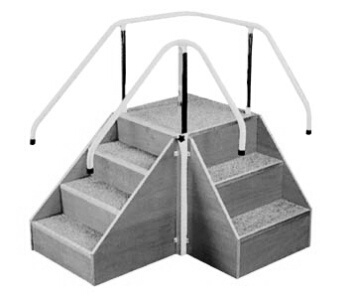Imperative in the design of stairs is consistency of tread depth and rise. Nicolas-François Blondel in the last volume of his Cours d’architecture (1675–1683) was the first known person to establish the ergonomic relationship of tread and riser dimensions, specifying that 2 x riser + tread = step length. Today, for ergonomic and safety reasons stairs must have specific dimensions, often provided in local Building Codes.
It is estimated that a noticeable mis-step occurs on a flight of stairs once in 7,398 uses and a minor accident occurs once in 63,000 uses. Whilst rarer, significant trauma and death can occur through stair falls. Subsequently, learning to safely and effectively navigate stairs is an essential skill of rehabilitation taught by physiotherapists. And often, it is the final evidence that a patient is fit to leave hospital.
Training stairs were manufactured for physiotherapy gymnasiums, and to save floor space and because of ceiling height limitations usually only three steps are built ascending to a platform. For variety an alternative rise of two steps or a ramp was built on the other side of the platform. Often the two flights are built at right angles on the square platform so the training device could be put in a corner of an otherwise crowded gymnasium.
Where one leg was not functioning normally and crutches were being used the training advice to help patients remember their stair strategy was “Good leg to heaven (ascending) and bad leg to hell (descending)”.
Description provided by Glenn Ruscoe of Australia.
References:
Stair Safety: A Review of the Literature and Data Concerning Stair Geometry and Other Characteristics. 1992. Prepared for the US Department of Housing and Development. Accessed online at https://web.archive.org/web/20060923030540/http://www.toolbase.org/Best-Practices/Codes-Regulations-Standards/stair-safety on 15 October 2021.

